热门标签
热门文章
- 1php+绕过cookie验证,Selenium中使用Cookies绕过登录
- 2程序员35岁之后不写程序了,该怎样职业规划?_会写程序的人如果不做软件开发还能做哪些相关工作?
- 3docker 部署 dujiaoka 独角数卡自动售货系统 支持 X86 和 ARM 架构
- 4Centos SQL Server保姆级安装教程_centos安装sqlserver
- 5MacOS13+系统运行Stable Diffusion出现的问题及解决方法汇总_stable diffusion 生成全是马赛克
- 6怎么抠图最简单?教你一行Python代码去除照片背景_python去除图片背景
- 7springboot属性注入方式_springboot枚举怎么才能注入
- 8由PyRetri浅谈基于深度学习的图像检索
- 9Appium安装及开发环境配置_appium安装及环境配置
- 10Only fullscreen opaque activities can request orientation比较完美的解决方法,黑白屏问题解决
当前位置: article > 正文
PaddleOCRv3之二:TextRecognitionDataGenerator训练集构造
作者:Gausst松鼠会 | 2024-04-04 18:56:20
赞
踩
textrecognitiondatagenerator
OCR识别部分数据集中字体和背景是比较重要的方面,在实际的场景下收集不到那么多真实的样本,在训练开始的时候手工构造一批训练数据还是很有必要的。可以用这一批数据预训练后面用真实数据来微调,也可以直接把这些数据和真实数据混合在一起训练。
在构造数据集的方面TextRecognitionDataGenerator还是比较好用了,这是按行生成文本的,可以生成bounding boxes,和mask。
1. 开源项目TextRecognitionDataGenerator
链接TextRecognitionDataGenerator
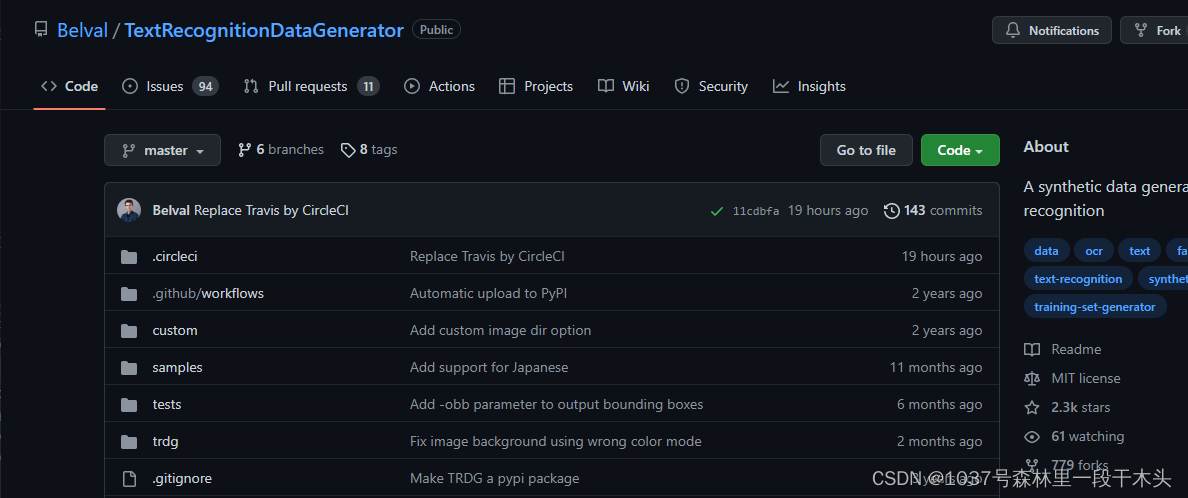
支持的一些有用的操作
- blur 模糊操作
- 在背景图上写字(这个很有用,选择一些真实场景的背景图,然后把文字写在上面,看起来更真实一些)
- 角度旋转
- 生成boundingbox和mask标签
- 字间距调整
- 字体颜色设置
- 拉丁语系的提供了100多种字体
- …
安装有两种方式,
- pip 安装
pip install trdg
- 1
- 源码安装
下载源码,cd进入setup.py所在目录,然后安装依赖项
pip install -r requirements.txt
- 1
使用的时候用trdg文件夹下的run.py文件生成数据,默认在TextRecognitionDataGenerator-master\trdg路径下
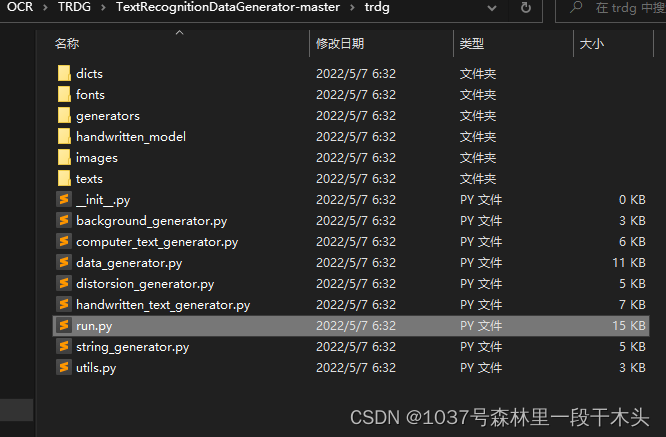
2. 使用
常用选项
python run.py --font_dir fonts\latin #字体文件,可以选择文件夹或者单个字体库 --dict dicts\myDict.txt #字典路径 -c 50 #一共生成多少个图片 --output_dir outputs #保存路径 -k 5 -rk #-k 5表示旋转的角度为5°,后面接-rk表示在-5,+5范围内随机, -bl 3 -rbl #-bl 表示blur 高斯模糊,后面接半径, -rbl表示高斯核的半径在0-3之间 --case upper #upper表示使用大写字符,lower表示用小写 -b 3 -id images #-b表示背景,3表示用图片做背景,-id:image_dir,指定背景图片路径 -f 64 # --format ,生成的图片的高度 -tc #22211f #--text_color 6位的16进制数,RGB格式直接翻译,例如:rgb=[10,15,255]==>#0a 0e ff -obb 1 #生成bonding box, #格式是嵌套的,第一行:4个数,分别为第一个字符左上角x,y 最后一个字符的右下角的x,y #第二行:4个数,分别为第二个字符左上角的x,y,最后一个字符的右下角的x,y #第n行:4个数,分别为第n个字符左上角的x,y,最后一个字符的右下角的x,y
- 1
- 2
- 3
- 4
- 5
- 6
- 7
- 8
- 9
- 10
- 11
- 12
- 13
- 14
- 15
- 16
例如:
python run.py --font_dir fonts\latin --dict dicts\OCRDict.txt -c 52 --output_dir K:\imageData\OCR\ocr_dataset\test -k 6 -rk -bl 1 -rbl -b 3 -id K:\imageData\OCR\ocr_background\yellow -f 80
- 1
查看使用帮助就能只知道完整的用法了
python run.py --help
- 1
usage: run.py [-h] [--output_dir [OUTPUT_DIR]] [-i [INPUT_FILE]] [-l [LANGUAGE]] -c [COUNT] [-rs] [-let] [-num] [-sym] [-w [LENGTH]] [-r] [-f [FORMAT]] [-t [THREAD_COUNT]] [-e [EXTENSION]] [-k [SKEW_ANGLE]] [-rk] [-wk] [-bl [BLUR]] [-rbl] [-b [BACKGROUND]] [-hw] [-na NAME_FORMAT] [-om OUTPUT_MASK] [-obb OUTPUT_BBOXES] [-d [DISTORSION]] [-do [DISTORSION_ORIENTATION]] [-wd [WIDTH]] [-al [ALIGNMENT]] [-or [ORIENTATION]] [-tc [TEXT_COLOR]] [-sw [SPACE_WIDTH]] [-cs [CHARACTER_SPACING]] [-m [MARGINS]] [-fi] [-ft [FONT]] [-fd [FONT_DIR]] [-id [IMAGE_DIR]] [-ca [CASE]] [-dt [DICT]] [-ws] [-stw [STROKE_WIDTH]] [-stf [STROKE_FILL]] [-im [IMAGE_MODE]] Generate synthetic text data for text recognition. optional arguments: -h, --help show this help message and exit --output_dir [OUTPUT_DIR] The output directory -i [INPUT_FILE], --input_file [INPUT_FILE] When set, this argument uses a specified text file as source for the text -l [LANGUAGE], --language [LANGUAGE] The language to use, should be fr (French), en (English), es (Spanish), de (German), ar (Arabic), cn (Chinese), ja (Japanese) or hi (Hindi) -c [COUNT], --count [COUNT] The number of images to be created. -rs, --random_sequences Use random sequences as the source text for the generation. Set '-let','-num','-sym' to use letters/numbers/symbols. If none specified, using all three. -let, --include_letters Define if random sequences should contain letters. Only works with -rs -num, --include_numbers Define if random sequences should contain numbers. Only works with -rs -sym, --include_symbols Define if random sequences should contain symbols. Only works with -rs -w [LENGTH], --length [LENGTH] Define how many words should be included in each generated sample. If the text source is Wikipedia, this is the MINIMUM length -r, --random Define if the produced string will have variable word count (with --length being the maximum) -f [FORMAT], --format [FORMAT] Define the height of the produced images if horizontal, else the width -t [THREAD_COUNT], --thread_count [THREAD_COUNT] Define the number of thread to use for image generation -e [EXTENSION], --extension [EXTENSION] Define the extension to save the image with -k [SKEW_ANGLE], --skew_angle [SKEW_ANGLE] Define skewing angle of the generated text. In positive degrees -rk, --random_skew When set, the skew angle will be randomized between the value set with -k and it's opposite -wk, --use_wikipedia Use Wikipedia as the source text for the generation, using this paremeter ignores -r, -n, -s -bl [BLUR], --blur [BLUR] Apply gaussian blur to the resulting sample. Should be an integer defining the blur radius -rbl, --random_blur When set, the blur radius will be randomized between 0 and -bl. -b [BACKGROUND], --background [BACKGROUND] Define what kind of background to use. 0: Gaussian Noise, 1: Plain white, 2: Quasicrystal, 3: Image -hw, --handwritten Define if the data will be "handwritten" by an RNN -na NAME_FORMAT, --name_format NAME_FORMAT Define how the produced files will be named. 0: [TEXT]_[ID].[EXT], 1: [ID]_[TEXT].[EXT] 2: [ID].[EXT] + one file labels.txt containing id-to-label mappings -om OUTPUT_MASK, --output_mask OUTPUT_MASK Define if the generator will return masks for the text -obb OUTPUT_BBOXES, --output_bboxes OUTPUT_BBOXES Define if the generator will return bounding boxes for the text, 1: Bounding box file, 2: Tesseract format -d [DISTORSION], --distorsion [DISTORSION] Define a distorsion applied to the resulting image. 0: None (Default), 1: Sine wave, 2: Cosine wave, 3: Random -do [DISTORSION_ORIENTATION], --distorsion_orientation [DISTORSION_ORIENTATION] Define the distorsion's orientation. Only used if -d is specified. 0: Vertical (Up and down), 1: Horizontal (Left and Right), 2: Both -wd [WIDTH], --width [WIDTH] Define the width of the resulting image. If not set it will be the width of the text + 10. If the width of the generated text is bigger that number will be used -al [ALIGNMENT], --alignment [ALIGNMENT] Define the alignment of the text in the image. Only used if the width parameter is set. 0: left, 1: center, 2: right -or [ORIENTATION], --orientation [ORIENTATION] Define the orientation of the text. 0: Horizontal, 1: Vertical -tc [TEXT_COLOR], --text_color [TEXT_COLOR] Define the text's color, should be either a single hex color or a range in the ?,? format. -sw [SPACE_WIDTH], --space_width [SPACE_WIDTH] Define the width of the spaces between words. 2.0 means twice the normal space width -cs [CHARACTER_SPACING], --character_spacing [CHARACTER_SPACING] Define the width of the spaces between characters. 2 means two pixels -m [MARGINS], --margins [MARGINS] Define the margins around the text when rendered. In pixels -fi, --fit Apply a tight crop around the rendered text -ft [FONT], --font [FONT] Define font to be used -fd [FONT_DIR], --font_dir [FONT_DIR] Define a font directory to be used -id [IMAGE_DIR], --image_dir [IMAGE_DIR] Define an image directory to use when background is set to image -ca [CASE], --case [CASE] Generate upper or lowercase only. arguments: upper or lower. Example: --case upper -dt [DICT], --dict [DICT] Define the dictionary to be used -ws, --word_split Split on words instead of on characters (preserves ligatures, no character spacing) -stw [STROKE_WIDTH], --stroke_width [STROKE_WIDTH] Define the width of the strokes -stf [STROKE_FILL], --stroke_fill [STROKE_FILL] Define the color of the contour of the strokes, if stroke_width is bigger than 0 -im [IMAGE_MODE], --image_mode [IMAGE_MODE] Define the image mode to be used. RGB is default, L means 8-bit grayscale images, 1 means 1-bit binary images stored with one pixel per byte, etc.
- 1
- 2
- 3
- 4
- 5
- 6
- 7
- 8
- 9
- 10
- 11
- 12
- 13
- 14
- 15
- 16
- 17
- 18
- 19
- 20
- 21
- 22
- 23
- 24
- 25
- 26
- 27
- 28
- 29
- 30
- 31
- 32
- 33
- 34
- 35
- 36
- 37
- 38
- 39
- 40
- 41
- 42
- 43
- 44
- 45
- 46
- 47
- 48
- 49
- 50
- 51
- 52
- 53
- 54
- 55
- 56
- 57
- 58
- 59
- 60
- 61
- 62
- 63
- 64
- 65
- 66
- 67
- 68
- 69
- 70
- 71
- 72
- 73
- 74
- 75
- 76
- 77
- 78
- 79
- 80
- 81
- 82
- 83
- 84
- 85
- 86
- 87
- 88
- 89
- 90
- 91
- 92
- 93
- 94
- 95
- 96
- 97
- 98
- 99
- 100
- 101
- 102
- 103
- 104
- 105
- 106
- 107
- 108
- 109
- 110
- 111
- 112
- 113
- 114
- 115
- 116
- 117
- 118
- 119
- 120
- 121
- 122
- 123
- 124
- 125
- 126
- 127
- 128
- 129
- 130
- 131
- 132
- 133
- 134
- 135
- 136
3. 示例
- 下面这几张图是原项目中的示例图





- 下面的图片使用的是真实场景下的一些背景图,按字典把字符写在上面
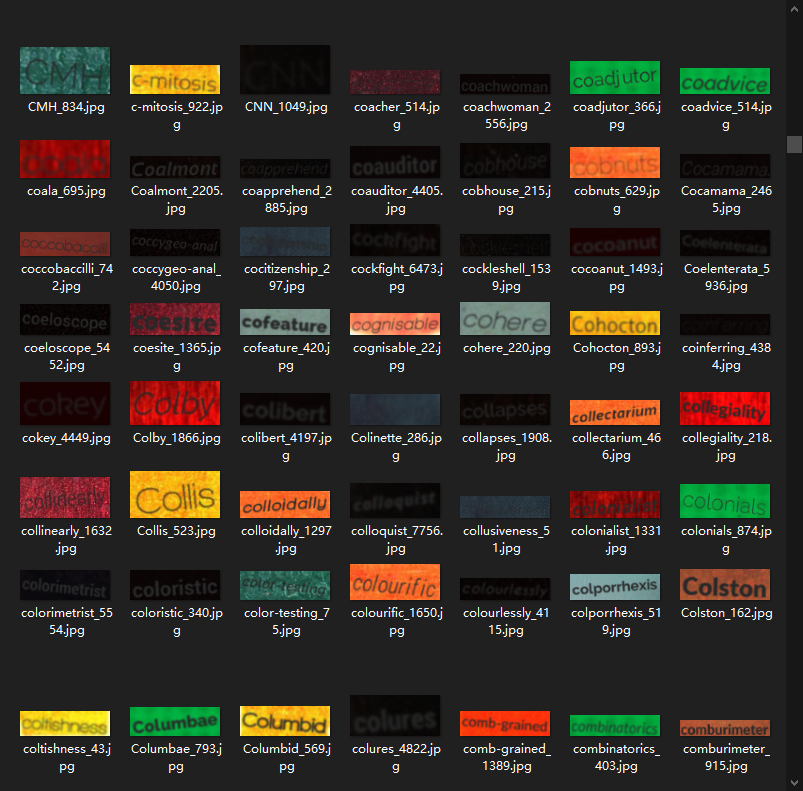
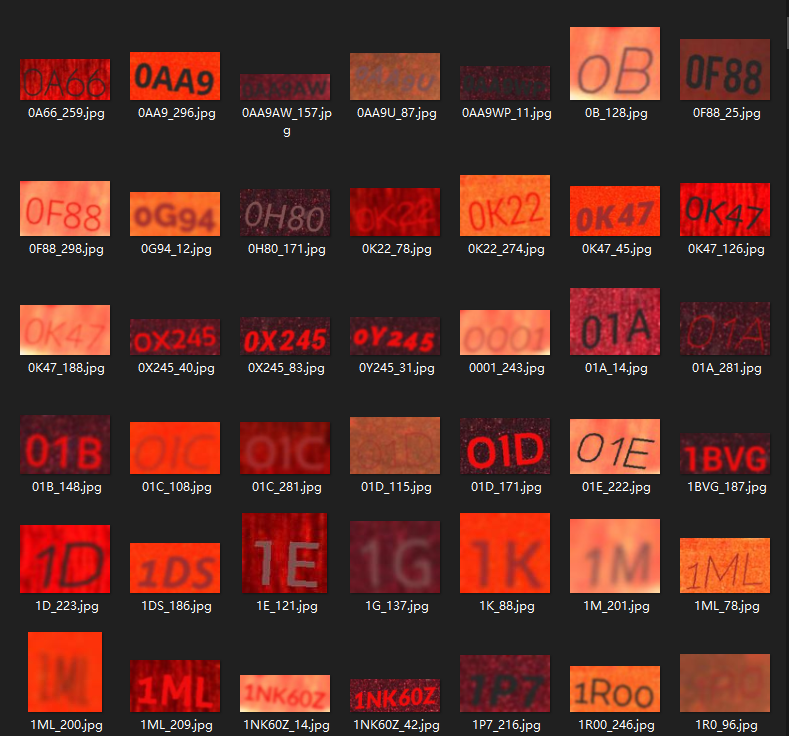
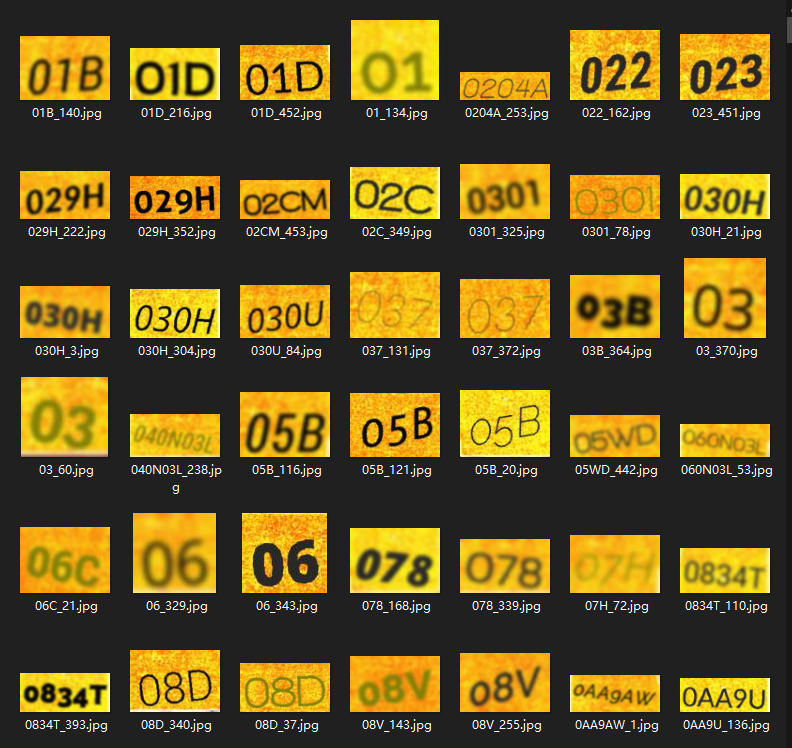
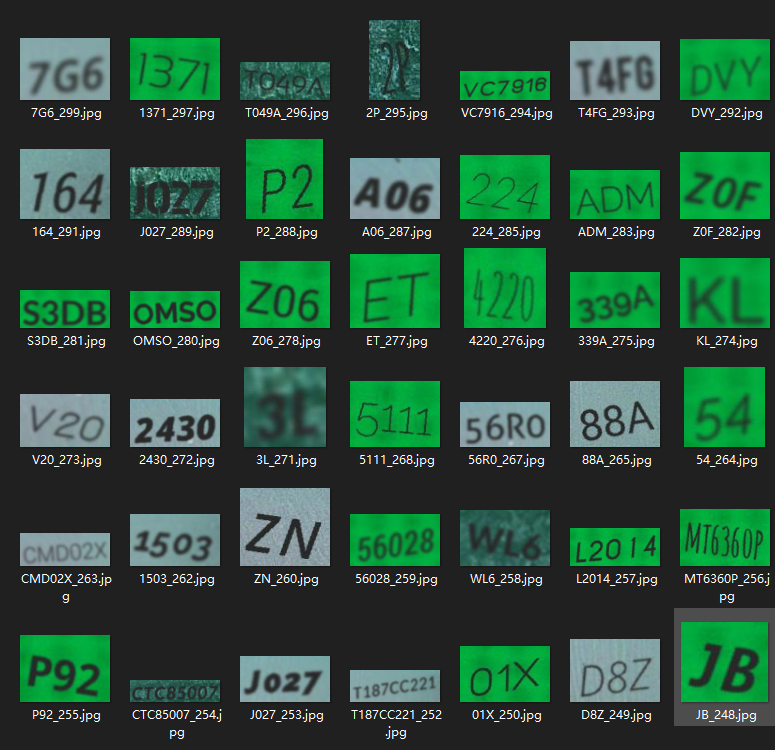

声明:本文内容由网友自发贡献,不代表【wpsshop博客】立场,版权归原作者所有,本站不承担相应法律责任。如您发现有侵权的内容,请联系我们。转载请注明出处:https://www.wpsshop.cn/w/Gausst松鼠会/article/detail/360492?site
推荐阅读
相关标签



